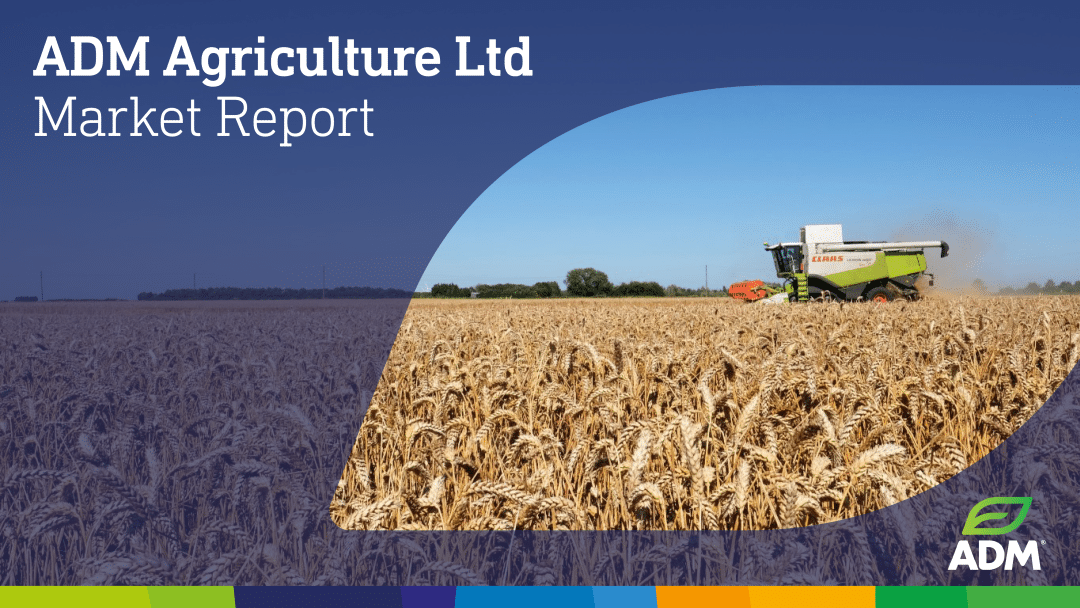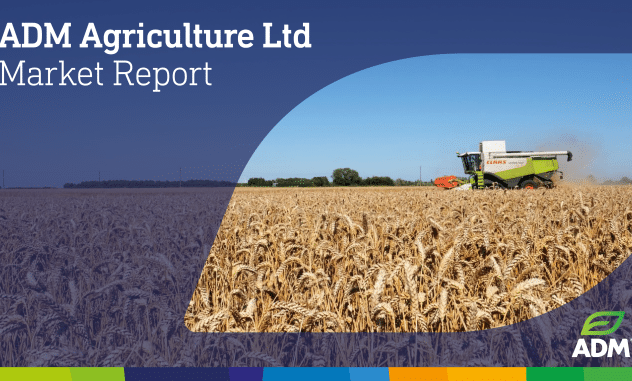WELCOME TO THE ADM AGRICULTURE WEEKLY MARKET REPORT
Wheat
- The US market has firmed $14.42/t w/w and is now an impressive $22/t above the recent low set early last week. Technical buying emanating from last week’s liquidation into the September first-day notice, and the weekly reversal, has driven the rally.
- US exports were strong and are now seen up 32% y/y and remain just ahead of the pace required to achieve the current seasonal projection. US winter wheat planting has just commenced, with the spring wheat harvest now over 70% complete.
- EU prices have followed suit, up €7.50/t w/w, albeit the firmer relative euro/dollar has capped gains. Wheat exports have reached just 4.38mln t so far this season, down 23% y/y, and with the French export book almost non-existent, earlier Eastern EU/Baltic exports are carrying the baton. Aggressive exports from Russia and Ukraine (up 89% y/y) have taken up the slack in EU exports, and with no apparent sign that export prices are firming from the region, they will continue to undercut EU export opportunities with MATIF firming.
- UK prices have added a modest £1.60/t w/w. The recent rise in the market has the consumption trade asking why and is giving growers even less enthusiasm to sell fresh supplies onto the market. Currently, available supplies are just about matching demand, but with reports from EU data reporting the UK has received 278kmt of EU wheat during July and August, official figures for the first two months of the 2024/25 marketing season could show wheat imports of more than ½ million tonnes.
- In summary, there are question marks over the longevity of this rally. Black Sea prices do not seem to be following and will continue to be the barometer for cheap global exports, and if demand wanes, or stays away from the US, the market is open for a bout of ‘profit-taking.’
Barley
- For another week, the feed barley market is characterised by tightness caused by a lack of liquidity. The continued lack of farmer selling, in combination with good demand from feed consumers, is squeezing prices higher in an attempt to limit demand and encourage farmers to the table, which in combination with higher futures has caused the feed barley price to perform well over the last week.
- Export markets are quiet, and we remain uncompetitive into nearby destinations vs both other products and other origins.
- We expect that activity will remain slow until farmers come to the table, at which point, with the lack of export demand and a building surplus, we could see pressure creep into the feed barley market.
- The spring barley harvest continues to move North and malting quality remains excellent across the board with very little failing to make spec. Markets are heavy as a result and for another week demand is slow. Premiums continue to be squeezed, exacerbated by the continued push higher in feed.
Rapeseed
- Ag markets have been largely higher this week, with US and Canadian markets shut for Labour Day on Monday. The main point of note from this week has been China announcing investigations into anti-dumping on Canadian canola imports, which has pressured veg oils. This is following Canada’s announcing a 100% import tariff on Chinese EVs. This news led to the canola trading limit down on Tuesday, $45 lower before recovering into the close. In the past year, Canada has ramped up their exports to China, totaling 4.6mln t in the 2023 calendar year with 1.6mln t of this still to be delivered. Currently, this is not posing problems, but additional purchases are motivated by these inquiries.
- Soybeans have traded higher this week, as dryness in Brazil, alongside an improved case for demand helped support prices. In Brazil, the planting window is only 1-2 weeks away and we are yet to see any moisture, which is mainly an issue as this year’s dry season started earlier than we would usually expect. AgRural has pegged Brazil plantings 9% higher than last year at the slowest rate of growth in 18 years. This would indicate production of circa 168mln t subject to favourable weather, though this is not likely.
- This week’s US crop conditions also came in 2% lower at 65% good/excellent, although expectations were for a 1-2% decrease. US soybean crush hit a new July record high at 193.46 million bushels, up from the previous record of 184.3 million last year. This was also above the highest estimate. This week we have seen China continue to improve on its new crop coverage, but it still has a way to go.
- Energy markets have been sharply lowered this week as China’s PMI report renews demand concerns. The August figure was higher than expectations at 50.4, however, the trade seemed to focus on a decline in new export orders for the first time in eight months. OPEC oil output in August is estimated to fall to 26.36 million barrels per day – the lowest since January. OPEC+ is scheduled to ease quotas next month therefore increasing production though this is TBC.
- MATIF rapeseed has been mixed this week, largely following news from China, but prices are reluctant to drop looking at this year’s tight EU S&D. We do remain in a downtrend, and seasonality points lower for the start of September, but for now, support at €465 remains strong. This week the canola/MATIF spread has widened $20 back out to $87, as canola looks for a new home. In Australia, ABARES has released its most recent crop update following favourable conditions in recent weeks. Rapeseed was increased to 5.47mln t from 5.39mln t previously but remains behind last year’s 5.93mln t.
Oats
- Oat markets have seen further negative price movements this week due to the lack of buyers in the market.
- Production prospects in Scandinavia remain very good despite reports of some high mycotoxin levels and wet weather affecting unharvested crops.
- Quality in Sweden/Finland is reported to be good in general and this has been weighing on milling oat prices.
- Feed oat demand is virtually non-existent. Areas of the Baltics and Scandinavia will hope for an increase in domestic demands to accommodate crops that are unsuitable for human consumption.
- Here in the UK, prices have fallen further week on week, with millers being cautious about demand and needing to regain competitiveness with international end buyers after being the most expensive origin of oat products last year.
- The quality of the crops planted pre-April has been good, but the remaining tonnages could be impacted by the wet weather that we are currently experiencing.
- The UK is now priced competitively for exports and awaits the buying tenders to accommodate our exportable surplus.
- Bottom line, both milling and feed oat markets continue to fall from the highs set last year due to the bounce in supply and lack of demand.
Pulses
- At the time of writing, it is a cool, grey, damp day here in Lincolnshire. Who would’ve thought that at the start of September, there is still plenty of beans to cut… Spring beans, especially across the northern half of the UK, are rapidly approaching readiness, with growers indicating that beans around North Lincolnshire should be fit in the next 10 days, while those further north, as we pass York, are more like 15-20 days away. It is worth noting that while the weather may not make us feel that harvest is progressing, we are pretty much on track, and as one of our farm traders mentioned to me today – while they weren’t 15%, he has seen beans cut as late as December are perfectly fit (with a little bit of drying)! Again, domestic consumption markets remain quiet as beans do not look good enough to buy their way into winter diets – YET. Baltic new crop should start being cut in style in the coming days, so we will see what this brings to the international human consumption markets.
- Standing crops still look reasonably well, and a steady flow of samples through our lab shows relatively low levels of admix and ‘clean threshing’. Although it is grey and drizzling here today, the week ahead shows fairly heavy rain for most of the south of the UK, with as much as 80mm in some areas, and the north will remain dry. Eastern temperatures will be a little warmer than normal, however, nothing to write home about. Either way, this should allow some more combining to be done.
- Another quiet week of price evolution for beans, with premiums vs London wheat futures again MoL unchanged, with the flat pricing tracking the London Feed Wheat market. Beans remain c. £10-15/mt too expensive on a relative basis, to be featured in any great volume for the winter-feeding positions. Keep a close eye on this, as they will need to correct lower, and this could well tie in with spring bean harvest volumes increasing.
- GBP has firmed up over the last week or so, however on the short-term outlook, GBPUSD indicates potential weakness as economic uncertainties in the UK and concerns over public finances weigh on the pound. Conversely, a possible US dollar decline may offer some support. GBPEUR remains vulnerable amid persistent inflation pressures in the UK, but expectations of steady UK interest rates could prevent significant declines. Crudely, strong GBP = cheaper imports/weak GBP = more aggressive exports.
- Beans may still be standing in the field, however the drilling window for winter pulses is soon approaching. Now is a good time to talk to your farm trading representative about all things pulses! With a combination of some great marketing options, various seed stocks ready to go, and a portfolio of cost-effective inputs, such as P-Grow and FibroPhos, that can help push your yield potential, they are ready and happy to help. We have a wide spread of homes nationally, so can offer competitive origination markets, plus the opportunity to upgrade human consumption pulses to be processed in one of the most advanced pulse processing plants in the UK and Europe.
- Finally, the ever-present PGRO plug to those eligible to be members. If you are not already signed up to the PGRO mailing list, you can sign up here where levy payers can access all sorts of advice and support, tapping into their extensive knowledge bank on all things pulses for free! The PGRO is a unique organisation within the UK, and if you are paying for it, you may as well use it!!
Seed
- As we dive into September and the focus begins to move toward the drilling window, several varieties are now in high demand and stocks are starting to run short. Group 1 varieties, Skyfall, Crusoe & SY Cheers, have gone very short in the marketplace and will be difficult to find until merchants finish cleaning stocks. Much the same applies to the Group 2 varieties, with only limited amounts of KWS Palladium & KWS Ultimatum being available with a buyback contract, so if you are looking for a Group 2 buyback, please give your ADM farm trader a call to secure the precious tonnage you require.
- Bamford has dominated the Group 3 sales from the start and with little left available for sale at this time, strong demand for all Group 4 types is now appearing, so if you are looking for Dawsum, Champion, or Graham, please contact your local ADM farm trader.
- There is high demand for SFI mixtures, from legume fallows to cover crops, with availability ever-changing. Make sure you secure your SFI requirements as soon as possible to avoid disappointment. There are multiple benefits to growing cover crops, including helping with soil structure, retaining nutrients, and providing an option for grazing for livestock.
Fertiliser
- India has dominated the news this week, booking 1.2MT in their recent buy tender and then requesting suppliers to consider adding further tonnage.
- Prices in the US and South America moved up in the wake of this news and business in the Arab Gulf and Egypt picked up with more buyers now stepping back in.
- Ammonia pricing has also moved up again this week, now over $ 570 t compared to the $ 450 t quoted in May/June.
- Gas prices in the UK and Europe have retreated slightly this week but remain well above season lows continuing to pressure producers across Europe.
- CF Fertilisers remain in the forward market with a 34.5% Nitram price that remains ultra-attractive compared to any imported material.
- Potash prices appear little changed as global markets remain flat.
- Phosphate pricing remains firm, supported by ongoing demand.
- Recent rain in the UK has encouraged more oilseed rape plantings. ADM still has granular Piamon NS 33N + 30SO3 to offer for delivery in the Nov/December window.
| £/€ | £/$ | €/$ |
|---|---|---|
| 1.1860 | 1.3165 | 1.1100 |
| Feed Barley £ | Wheat £ | Beans £ | Oilseed Rape £ | |
|---|---|---|---|---|
| Nov 24 | 150-165 | 175-190 | 220-230 | 390-395 |
NB: Prices quoted are indicative only at the time of going to press and subject to location and quality.
“Although ADM Agriculture take steps to ensure the validity of all information contained within the ADM Agriculture Market Report, it makes no warranty as to the accuracy or completeness of such information. ADM Agriculture will have no liability or responsibility for the information or any action or failure to act based upon such information.”
ADM Agriculture cannot accept liability arising from errors or omissions in this publication.
ADM Agriculture trade under AIC contracts which incorporate the arbitration clause.
Terms and Conditions of Purchase.
On every occasion, without exception, grain and pulses will be bought by incorporating by reference the terms & conditions of the AIC No.1 Grain and Peas or Beans contract applicable on the date of the transaction. Also, we will always, and without exception, buy oilseed rape and linseed by incorporating by reference the terms & conditions of the respective terms of the FOSFA 26A and the FOSFA 9A contracts applicable on the date of the transaction. It is a condition of all such transactions that the seller is deemed to know, accept and understand the terms and conditions of each of the above contracts.



